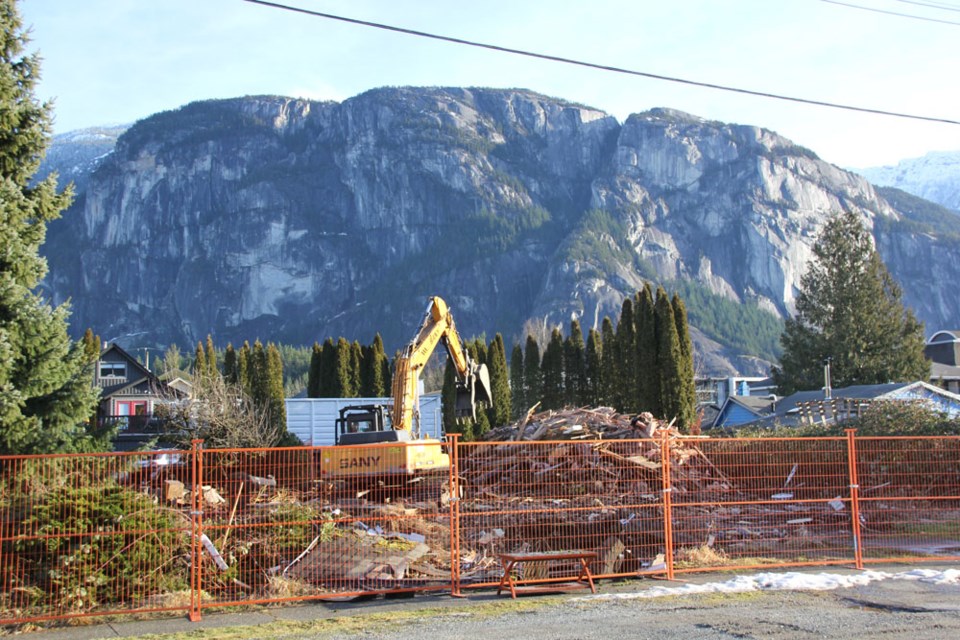On the same day that the District of Squamish council met to review the draft of the Arts, Culture and Heritage Strategy, just a few streets over the former Catholic Church on Fourth Avenue was being demolished.
Bianca Peters, the founder and president of the Squamish Historical Society (SHS) said she would have preferred if the society had been notified ahead of its destruction. Objects of importance such as old newspapers can be found in the walls of old buildings, and Peters said a grape tree on the property was at least 80 years old. Having a chance to document the remains of the church, she said, could have served as a way to preserve it, perhaps by adding an educational plaque.
As to why no one was notified of the church’s removal, Jonas Velaniskis, the director of community planning for the District, told The Chief in an email that the District does not have a Heritage Registry that would trigger notification “as part of the demolition or building permit process on private property.”
He added that District staff does work with property owners with buildings that may have some historical significance if there is a rezoning or variance because the District has some sway in those instances.
“In this case, there has been no application submitted for the property on Fourth Avenue.”

Heritage, Peters said, doesn't necessarily mean preserving the building itself. Instead, the society takes a values-based approach — it could be a person, a trail, a tree or a viewpoint.
"Heritage is no longer about preserving. It's about managing change," Peters said. "Because we understand that things are going to change, but we just want to make sure that we don't forget about it."
A few days after the church was taken down, on Feb. 1, the Squamish Heritage Society hosted its second workshop in Squamish. Building off the first workshop in November, local history enthusiast and Forestry Centre Society volunteer Eric Andersen presented an overview of Squamish history, progress by the District and what next steps may look like.
(Andersen was speaking as a citizen and not in his role as a District councillor.)
He pointed to the Parks and Recreation Master Plan, the Squamish Trails Master Plan and the Neighbourhood Plan as part of the District's progress on heritage. On the wish list is a heritage registry.
“Such a Heritage Registry impacts private property owners whose properties may be listed,” Velaniskis’ email continued. “If a local government were to require, through a registry, public notification of alterations on private property, there must be significant rigour (i.e. formal policy and regulation) in place to ensure that property owners clearly understand how heritage conservation takes place. It may also require compensation to be paid to the owner in some circumstances. Consultation with property owners, historians and the broader community makes this a significant project to embark upon. It’s a far more complex process than simply identifying all the old buildings in a community.”
Drafting a strategy
The District of Squamish is currently moving forward with a draft of the Arts, Culture and Heritage Strategy. At the Jan. 28 council meeting, Andersen was the only councillor to vote against the draft, citing concerns about the lack of an archive in the strategy and the lack of policymaking.
"There is no mention of conservation of heritage in this report," Andersen said at the meeting. He pointed to a policy to create a municipal registry that was called for 27 years ago, but never came to fruition. Likewise, the idea of a heritage tree bylaw that came to council 23 years ago didn't take root.
"The heritage community and the arts community cannot write policy," Andersen continued. "That's our job."
Coun. John French also told council he felt heritage didn't receive the level of attention it deserves.
Peters, who attended the Jan. 28 council meeting, applauded Andersen's comments.
"I'd like to thank the District of Squamish for their great first steps, however, just to echo Coun. French and Coun. Andersen, there's not enough meat on the bones in terms of heritage," Peters said.
In a later interview with The Chief after his Heritage BC presentation, Andersen highlighted two main needs: identifying Squamish's community heritage through a registry and planning the cultural facility needs through an archive.
Creating an archive

Currently, different stakeholders such as SHS, the Sea to Sky Forestry Centre Society, the Squamish Public Library, the Squamish Chamber of Commerce and the District of Squamish have their own versions of archives, each held in separate locations.
"Each of us has archives. None of us have any kind of ideal situation — and it's costly. These documents, they are precious and they are fragile and they include photographs," he said.
While some families say they would give their personal artifacts to these groups, they want assurance the materials will be taken care of. But the societies often can't make such promises. Ideally, there would be a facility that has temperature control, easy access and can be used by many in the community.
One of the major catalysts that started the Squamish Historical Society was the closure of Woodfibre in 2006. When the industry-based community dispersed, local history enthusiasts feared the knowledge and records would leave with them. Indeed, Andersen pointed out that Squamish documents and historical photographs have been stored in a Squamish Historical Society locker, paid for by Woodfibre LNG.
"We're not particularly looking for a building or a museum. We're just looking at support to strike up a registry and a heritage commission, so that for example when things like the church or the Chieftain sign come up and the District is unable to make some sort of comment, they then at least have a stakeholder body that can say, 'OK, that means a lot. These are best practices...'" Peters said.
She added there should be a fund like the public arts commission fund.
Bringing records and documents together in a comprehensive way could also include digitizing them, to make materials more accessible. An interactive app or even a map of historic landmarks for tourists are ideas that have been floated.
Carrying the legacy forward
And it's not just the old that could benefit. New developments, Peters and Andersen said, such as the waterfront could use historical knowledge to their advantage. Andersen showed examples of waterfront developments around the world looking remarkably similar to those going up in Squamish.
"Where's the soul of Squamish?" Andersen asked during an interview with The Chief.
He'd like developers to reflect the history of the waterfront, which was once the gateway to Squamish for visitors coming by ferry or train and was the point of first contact.
Developers, he said, "can see the advantages in creating a distinctive project, and one that has a brand and relates to the place. What we need to do better in Squamish is help them [with] orientation about this place. What are the features that we should be protecting in the developments that they're doing?
That is the aim through education, artifacts and documentation.
"This is how we can help affect the development of Squamish while maintaining our identity, our heritage, our soul is to make sure that the stories are known, how we developed," he added.
A strategic planning session will be held by the stakeholders, and facilitated by the Squamish Chamber of Commerce, as they determine short and long-term goals for heritage.
Staff is currently reviewing the draft of the District’s strategy, as they make revisions for council's feedback. Then, a public consultation will be scheduled.
**Please note, this story has been corrected since it was first posted. The original version incorrectly said that the latest meeting was hosted by Heritage BC when it was presented by the Squamish Historical Society. It also said the Woodfibre documents were being stored in Victoria. They are in Squamish.




